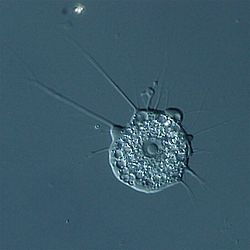| Nuclearia | |
|---|---|
 | |
| Nuclearia thermophila | |
| Scientific classification | |
| Domain: | Eukaryota |
| Order: | Rotosphaerida |
| Family: | Nucleariidae |
| Genus: | Nuclearia Cienkowsky, 1865 [1] |
| Type species | |
| Nuclearia simplex Cienkowsky 1865 | |
| Species | |
See text | |
| Synonyms | |
| |
Nuclearia is a genus of nucleariid amoebae with filose pseudopodia and discoid mitochondrial cristae. [2]
Nominal species treated as members of the genus include:
- Astrodisculus affinisSchouteden 1905
- Astrodisculus araneiformisSchewiakoff 1893
- Astrodisculus laciniatusPenard 1904 [Chlamydaster lacinatus(Penard 1904) Rainer 1968]
- Astrodisculus marinusKufferath 1952
- Astrodisculus minutusGreeff 1869
- Heliophrys variabilis
- Nuclearina similis
- N. amphizonellaePenard 1917
- N. conspicuaWest 1903
- Nuclearia delicatulaCienkowsky 1865 [3]
- N. lohmanniKufferath 1952
- N. pseudotenelloides
- N. flavescens(Greef 1869) Patterson 1984 [Astrodisculus flavescensGreeff 1869]
- N. flavocapsulata(Greef 1869) Patterson 1984 [Astrodisculus flavocapsulataGreeff 1869; Astrodisculus penariRoskin 1929; Astrodisculus serratusWalton 1930; Heliosphaerium polyedricumFrenzel 1897]
- N. leuckarti(Frenzel 1897) Patterson 1984 [Nuclearina leuckartiFrenzel 1897]
- N. moebiusiFrenzel 1897
- N. pattersoniDyková et al. 2003 [4]
- N. polypodiaSchewiakoff 1863
- N. radians(Greef 1869) Patterson 1984 [Astrodisculus radiansGreeff 1869 sensu Penard 1904 non Stern 1924; Nucleosphaerium radians(Greef 1869); Nucleosphaerium tuckeriCann & Page 1979; Heliosphaerium asterFrenzel 1897; Heliophrys variansWest]
- N. simplexCienkowsky 1865 [Nuclearella variabilisFrenzel 1897]
- N. thermophilaYoshida, Nakayama & Inouye 2009 [5]
- N. rubra(Greef 1869) Patterson 1984 [Astrodisculus rubraGreeff 1869; Astrodisculus zonatusPenard 1904; Nuclearia caulescensPenard 1903: pro parte; Nuclearia zonatus(Penard 1904) Siemensma 1981]
The type species is Nuclearia delicatula, which may adopt a spherical or a flattened body form.
There is considerable uncertainty as to the identity of species and genera, and this led to the inclusion in Nuclearia of taxa previously assigned to Astrodisculus, Nuclearella, Nuclearina, Heliosphaerium and Nucleosphaerium, and the diversity rendered to 9 clearly distinguishable species with the affinities of Astrodisculus araneiformis, A. minuta and A. marinus remaining unclear [6]